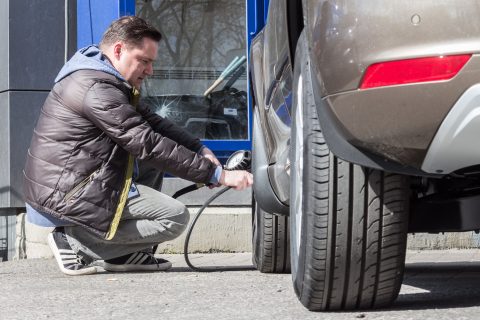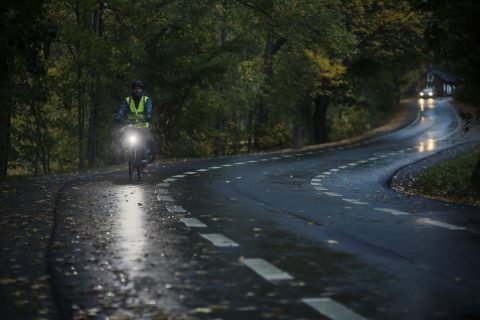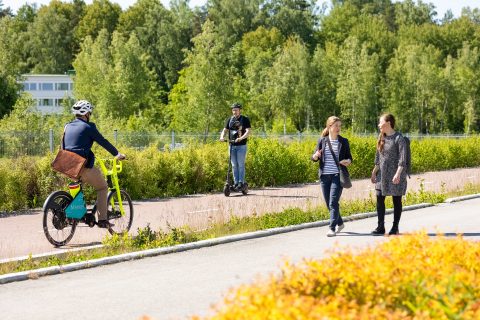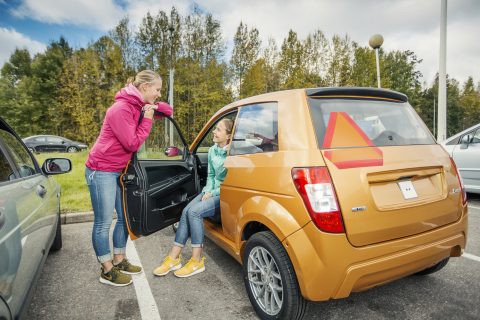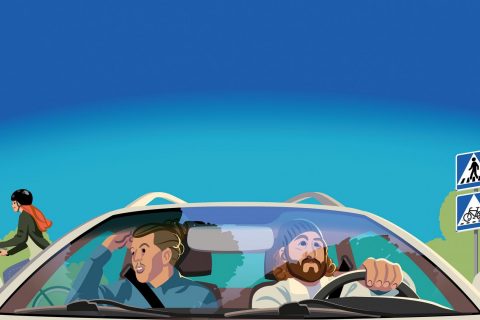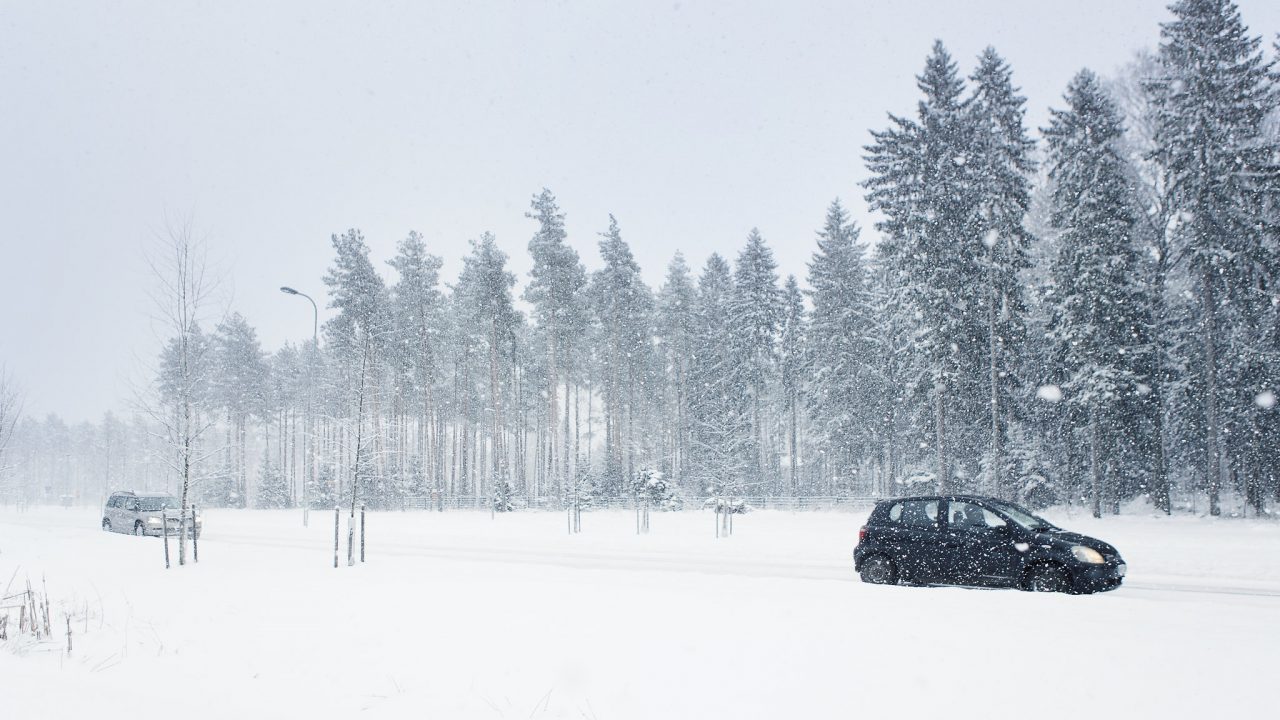
Difficult driving conditions
Snow, slush, heavy rain, ice or fog can present drivers a challenge. Anticipatory driving, reduced speed, increased following distance and extra vigilance are required when venturing out in adverse weather conditions. If possible, postpone the journey until the difficult conditions improve.
Varying conditions increase the risk of accidents
The risk of accidents is high in varying conditions. For example in wintertime the accident risk is highest at the beginning and end of the season. Stable weather conditions, be it dry weather in the summer or snowfall in the winter, make it easier for drivers to adjust their driving to the conditions compared to when the weather changes suddenly. Studies show that the rarer the weather, the higher the accident risk.
Smart drivers make a habit of checking the weather reports and traffic updates. Awareness of conditions will help you be more prepared.
If difficult conditions are ahead, challenge your need to take the journey: consider rescheduling or using alternative transport. If you must travel, plan ahead: reserve more time for your journey or reroute the drive. For example major roads are usually the first to to be cleared of snow. Check tyres, brakes, windscreen wipers, lights and fluid levels to make sure that your vehicle is roadworthy.
Varying weather conditions increase the risk of accidents. In winter, the risk of accidents is highest in the early and late winter.
Braking takes longer on slippery roads
When the road are slippery, braking takes longer and the driver’s incorrect assessments result in immediate consequences. If you drive at 80 km/h on a dry asphalt road, you need almost 50 m and about four seconds to stop. On a snowy road stopping takes twice as much distance and time. On an icy road, the braking distance with the same speed can be over 180 meters.
Thus it is vital to increase your following distance from other road users significantly and drive at a sensible speed. Too short a distance increases the risk of rear-end collisions. Many disastrous collisions with incoming traffic also originate from short distances. Even good winter tyres will not produce the traction of summer weather.
A sufficient safety distance is vital in the winter and whenever the driving conditions are poor.
Be aware of black ice, aquaplaning and other autumn hazards
Driving conditions in Finland can be challenging already in autumn. The rain makes the asphalt wet which is much more slippery than dry road. Mud and wet leaves can also make the road slick, which can be hazardous particularly for two wheelers.
As the nighttime temperatures start to drop below freezing the road surfaces can be icy. Traction may vary greatly over just a short distance.
Especially in autumn black ice is something to watch out for. Black ice is a thin and often transparent coating of ice that can form quickly on the road surface. Black ice is exceptionally slippery and difficult to detect so you need to know when and where to expect black ice.
Black ice forms when a moist and cloudy evening or night is followed by a cold and sunny morning and the air cools quickly. Black ice can also form in sub zero temperatures when the snow, water or ice melts and re-freezes.
Black ice forms commonly
- on bridges and overpasses. This is because the cold air is able to cool both the top and under the bridge or overpass, bringing about faster freezing.
- on parts of the road in the shade.
- in the early morning and evening just about the freezing point.
The risk of black ice is high, especially on the hollows of the road.
If driving on wet roads water or slush can build up between the tyre and the road surface. This causes the tyre to lose contact with the road and the vehicle to lose response to steering. Aquaplaning or hydroplaning is likely to occur at high speed and when their is a buildup of heavy rain or mixed snow and rain on the surface of the road.
Best way to avoid aqualplaning is to
- reduce your speed in wet weather
- avoid driving in tracks or large puddles
- monitor the tread depth and air pressure of your tyres.
If aquaplaning occurs, keep calm, take your foot of the gas and depress the clutch and allow the speed to decrease. Do not hit the brakes. Avoid strong steering movements..
In addition to rainfall, the road surface may be made slippery by fallen leaves and by mud. Moped and motorcycle riders in particular should take this into account.
How to maintain traction in slippery conditions
When the roads are slippery, the driver can prevent the loss of traction.
- Gently accelerate using low revs so that the wheels are not spinning.
- Drive into curves at moderate speed to prevent the vehicle sliding sideways.
- Avoid driving at high speed through snowdrifts, water-filled tracks or puddles.
- If you drive with an older vehicle without ABS, avoid lock-braking. If the wheels are locked, the vehicle cannot be steered, but it will move according to the gradient of the road.
- Avoid strong steering movements.
- Avoid unnecessary lane changes. Avoid overtaking in bad weather slush etc. Loss of control in overtaking in slippery conditions occurs often when returning to the lane after overtaking.
Winter tyres
Winter tyres must be used from the beginning of November to the end of March, as long as weather conditions so require. Winter tyres can be either studded or non-studded. Non-studded winter tyres, so-called friction tyres, may be used all year round. However, for example, the Tyre Specialists of Finland (Opens in a new window) does not recommend friction tyres for year-round use due to their poor wet grip properties. Read more about winter tyres.
Visibility and observation
Especially in winter pay attention to visibility from the car before heading out. Remove the snow all around – also from the roof. Clear ice from the side and back windows, mirrors, and windscreen. Check if the windscreen wipers are frozen.
Clean the windscreen regularly from the inside. A dirty inner surface causes glare which reduces your vision. Especially low winter sun can create glare. Warming up the car and engine with the car’s heater is recommended when the temperature drops below zero.
When driving in the dark or twilight
- Remember to turn on the headlights. Use the high-beam outside illuminated areas whenever possible without dazzling others.
- Give yourself time to adjust to the light and shadows.
- Focus your gaze at the limits of the headlights.
- Don’t look directly at the headlights of incoming traffic – look further away to the right side of the road.
- Reduce speed. Lower speed gives you more time to observe and react to surprises. Especially in urban areas keep a lookout for vulnerable road users.
- Signal early. Give other road users plenty of notice that you are slowing down or turning.
In a fog, turn on your rear fog lights and check that the headlights are on. So not use high-beam heaflights as they will reflect the light off the fog ahead of you.
If the journey feels unsafe, reduce your speed, or pull over at a safe spot. The vehicle must not be left unlit in the road area.
Never drive faster than what is safe for the current conditions of the road. When driving in bad weather you should, above all, slow down and keep a decent safety distance.
In case of an emergency
Motorists know how hard it is to see a pedestrian without a reflector, even if the road is illuminated. When getting out of the car, motorists become pedestrians too, so remember to wear a reflector. Reflectors or reflector vests are especially needed if the vehicle breaks down or assistance is needed in the dark.
In case of an emergency or a breakdown in cold weather, carry along:
- warm clothes and shoes,
- reflective vests or reflectors – the reflective vest is a better option as it makes you visible to passing traffic even in bright conditions
- a flashlight.
Winter speed limits save lives
In Finland the preparation for the dark and cold winter starts with reducing speed limits on main roads around the country in October and November. Usually this means that in areas where the summer speed limit is 100 km/h, in winter it is 80 km/h.
The winter speed limits are put in place due to the increased darkness and winter driving conditions. The aim of reducing speeds is to reduce the risk of accidents due to seasonal fluctuations.
It has been estimated that the speed limits for winter and dark times save eight lives every year and keep another 36 people from getting injured. In the case of colliding with a deer, elk or reindeer, the greatest risk is in September–December, and the increase in speed significantly increases the risk of death or serious injury. Two thirds of the accidents resulting in personal injury occur during low-light or dark conditions, and 40 % of them occur in an area with a speed limit of 100 km/h.
